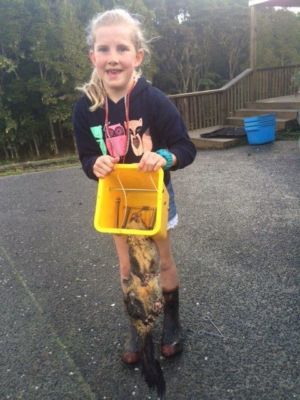The mice, rats, stoats, ferrets and possums in Rodney have been dining in style recently and many paid for it with their lives. Bacon, peanut butter and even blue vein cheese were all on the menu as the children at Kaipara Flats, Tomarata and Tauhoa Schools experimented to find out what baits worked best to entice predators into their traps.

In a three week period 80 mice, 31 rats and 112 possums fell victim to the various lures in a pilot programme run in the three schools by the Forest Bridge Trust. Mustelid footprints were recorded on tracking cards, but none were trapped. In 2016, the Forest Bridge Trust hopes to extend its CatchIT predator education programme into four more Rodney area schools.
Liz Maire, Education Project Coordinator for the Forest Bridge Trust encouraged the children to innovate. Liz aims to unlock curious minds and get children thinking scientifically. Statistics students from Auckland University came onboard too, creating bar graphs from the children’s data to help them visualise their results and see the positive impact their trapping was having.
CatchIT software has been developed by Auckland University to manage and analyse data for community pest control projects. The software takes data from trap-lines, bait-lines, and tracking tunnels and brings it to life on the screen using maps, graphs and other analyses. Liz has been working with the University team to develop the CatchIT Schools Programme and future plans for software development include a strategy game based activity where children can move traps on screen and try different baits, with the game results reflecting those the children are finding in reality.
It’s all part of the plan to get children motivated and to get them and their families trapping. The aim of the Forest Bridge Trust is to engage with its community and promote its vision of a ‘forest bridge’ of flourishing native wildlife, stretching from Kaipara Harbour in the west to the Pacific Ocean in the east. To achieve their vision, the registered charitable trust is connecting up bush remnants, fencing, planting and doing weed and pest control throughout the area. They work with local land owners, providing materials and manpower to help them care for the remaining pockets of forest on their farms and to extend and link the remnants through new native planting.
The pilot schools programme is a way to engage with local families through their children. Classroom sessions for the children look at ‘what is a pest?’, ‘have we got them?’ (the tracking cards that the children take home quickly answer this question) and ‘how do we catch them?’. The children’s families are invited to join a school community workshop where they are introduced to various types of traps and shown how to use them safely. Children each take home a tracking tunnel, 4 mouse traps, 2 rat traps and protective tunnels. If parents are keen to be involved too, they’re give a Timms possum trap and a DOC 200 for mustelids. Liz returns to the school three weeks later to check out how they’re doing and help the children analyse their results.
Liz has found that the children enjoy trapping and they are gaining statistical and scientific knowledge as they set up their experiments. Going by the feedback from families, the pilot CatchIT Schools programme has been a huge success. Here’s what one parent had to say at the end of the project:
− He loved it. It was a meaningful and purposeful project for a child who loathes homework. He learnt basic data gathering, pest control for environmental benefits and using traps safely & confidently. Sense of pride and achievement of being able to make a difference.


